If you’re interested in making homemade bread leavened with sourdough, you will not go wrong with this rye sourdough starter. Here are step-by-step instructions to make a flavorful starter for the bread-making process.
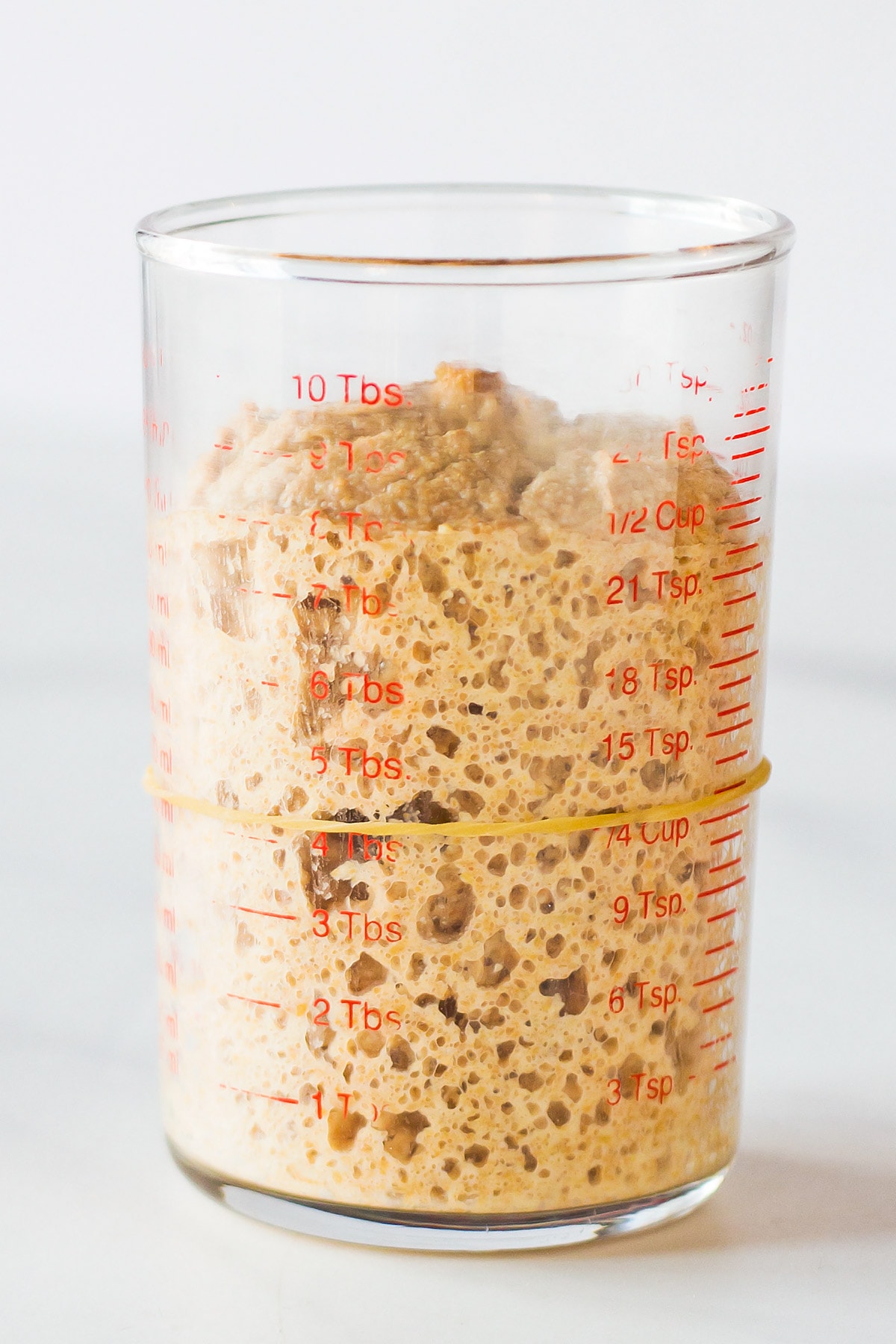
About this Rye Sourdough Starter
Last year not one, but two of my sourdough baking friends mentioned to me that they love their rye starter and have started using it exclusively. I couldn't write it off as coincidence and had to give it a try.
And sure enough, they've got me on their side now. I started a rye starter (I named her Harriet) and fell in love for four main reasons.
4 Reasons Why I Love Rye Sourdough Starter
1. Becomes active very quickly. I believe there must be a lot of natural yeasts & bacteria present in rye grains. Unlike all-purpose flour starters that can take almost 2 weeks to become active, I started seeing activity in my rye starter after just 1 day!!
2. Forgiving. Even when forgetting the starter on the counter, or after taking a break and placing it in the fridge, it always comes back like nothing happened.
3. Easy to stir. Because of the lower gluten level in rye flour, the starter mix doesn't become overly sticky and gluey. It's easy to mix together and clean off from spoons, spatula and jars.
4. Delicious! And most importantly, of course, is the delicious flavor that rye starter gives my homemade loaves of sourdough bread.
For those who don't know, a sourdough starter is essentially a replacement for the usual store-bought yeast in the bread-making process. As a result, you won't have to use store-bought yeast when making your bread.
Although you start this recipe with just rye flour and water, the mixture activated the natural yeasts present on rye grains and also garners yeast from your environment as it sits at room temperature. Then, it requires to be fed with additional flour and water until it is active enough to use to make bread.

Ingredients in Rye Sourdough Starter + Tools
Similar to other sourdough starter recipes, this starter includes just two ingredients. These include rye flour and water.
Be sure to use whole-grain rye flour that include the bran. This is sometimes also called dark rye flour.
Filtered water is the best option for anything sourdough related. If you only have tap water, let it stand at room temperature in order to let any chlorine in it evaporate.
For tools you need a small vessel like a jar or cup to mix in and store your starter. I like to use a small glass jar as it is clear, allowing for visibility as the starter develops. It is also the perfect compact size to hold a small amount of starter. In the pictures I am using this 5-ounce measuring jar (Amazon affiliate link). In the video I used this 1-cup 3 spout jar. Both are from Anchor-Hocking.
You also need a loose fitting lid or cover to protect the starter from dust and fruit flies. A piece of cloth or paper towel secured with a rubber band.
I am using a second rubber band to mark the level of the starter to easier observe its rise. You could also draw a line on the outside of the glass with a marker.
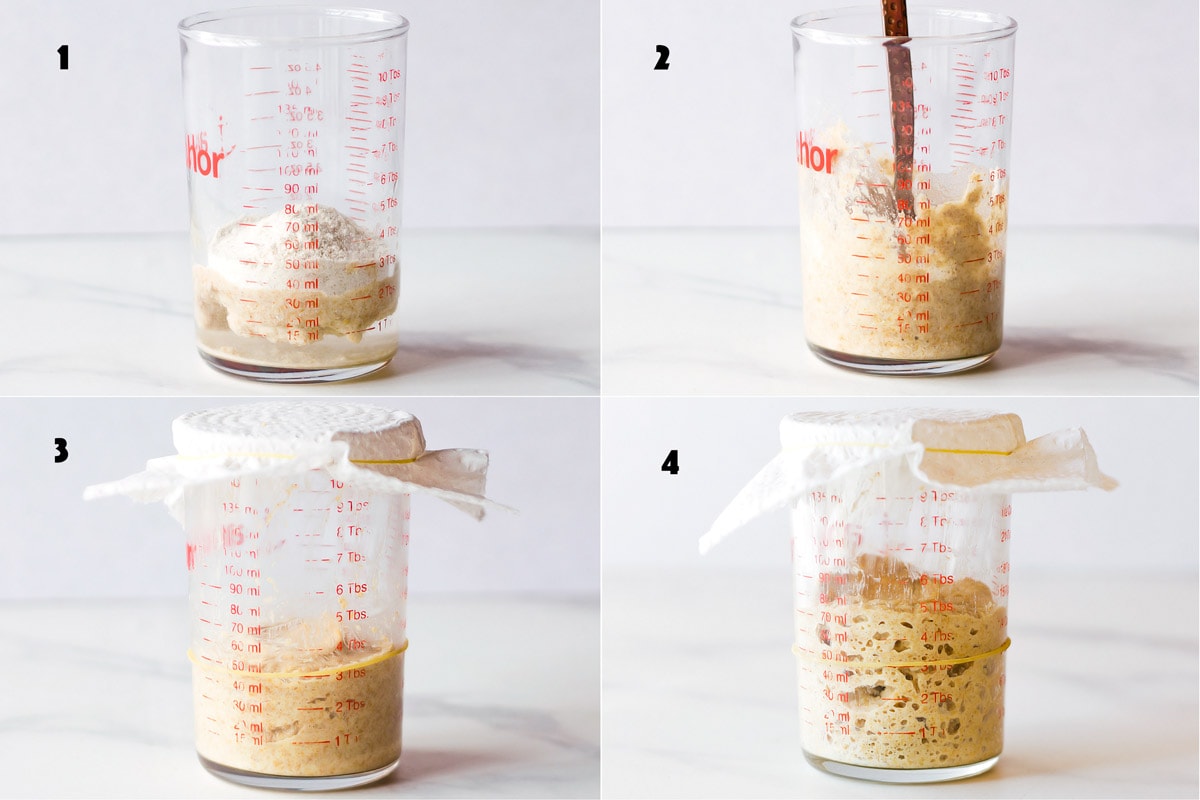
How to Make Rye Sourdough Starter
Day 1
1. To begin making your rye sourdough start, add 10 grams (1 tablespoon) of rye flour with 10 grams (2 teaspoons) of filtered water to a container or jar.
2. Combine the rye flour and water until fully combined. Then try to scrape the sides and push everything down to the bottom to create an even layer.
3. Mark the starting level of the sourdough starter with a rubber band or draw a line on the glass with a marker. To protect the mixture from dust, fruit flies etc. cover it with a piece of paper towel fastened with the jar ring or an elastic band. Then, simply allow it to sit at room temperature for one day.
Day 2
4. Within 24 hours you will notice some activity with the first bubbles forming and the starter slightly rising above the marked initial level.
The first feeding involves mixing another 10 grams rye flour and 10 grams of water into the starter. Cover the top and readjust the elastic band or draw a new marker line.
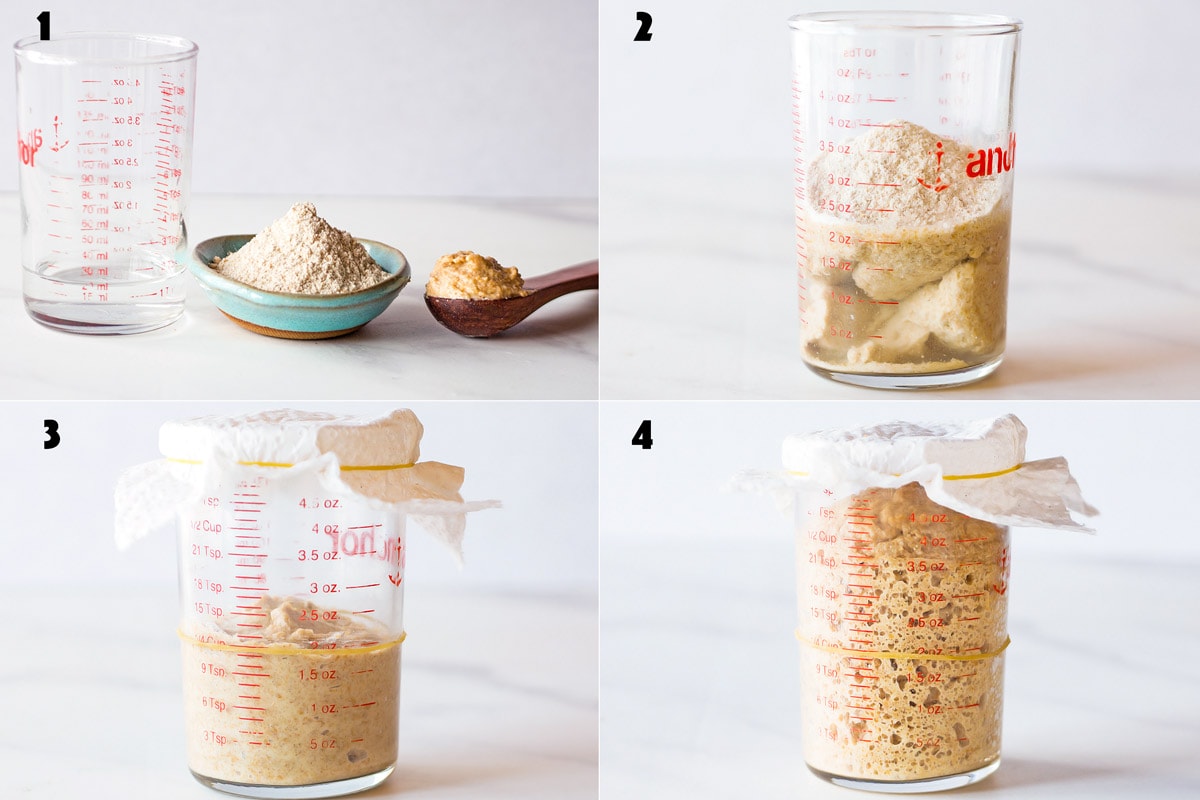
Day 3
On day 3, your starter should have risen above the elastic band, but it is unlikely to have doubled in size. At this point, you can remove half of the starter. This is called the discard. Read more about it below.
1. You should be left with about 20g of starter mix. You are going to feed it with another 10 grams of each flour and water.
2. Combine the starter, flour, and water. Stir the mixture together until combined.
3. Cover the top and mark the starting level with an elastic or marker line.
4. The mixture will bubble up and rise.
Days 4 to 7
Keep repeating the process from day 3 until you notice the starter doubles in size within in the first six hours after a feeding. Depending on your kitchen temperature and other factors this may take less than 7 days.
How to Know When Sourdough Starter is Ready
You will know that your sourdough starter is ready to use when it doubles in size, and particularly when it doubles within the first six hours after it is fed. However, there is another way you can check it. If you drop a small portion of the sourdough starter in a glass of water and it floats, you will know it is active enough to allow bread dough to rise.
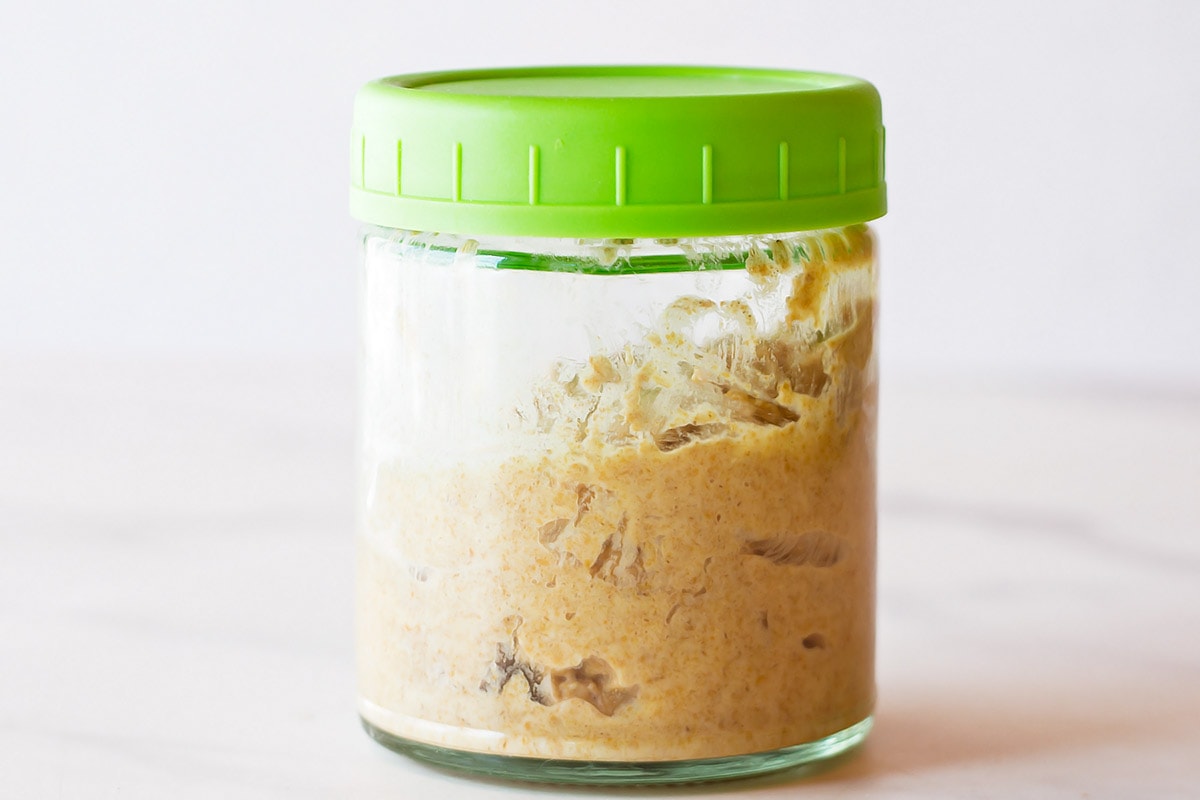
Maintenance
One of the reasons I like this rye starter so much, it takes very little maintenance. Once it has become active, I feed it only in anticipation of a sourdough bake. Which happens 1-2 times weekly right now.
In the mean time it is fine to remain on my shelf at room temperature. If you don't bake at least once a week, at least feed your room temperature starter weekly.
If you plan to travel, or just want to take a break from sourdough baking, seal your starter with a lid and move it into the fridge. It has always come back fully active after just 1 or 2 feedings for me.
Once you are ready to start up again, simply let your starter come back to room temperature and then feed it per usual as outlines in Day 3.
Sourdough Discard
I don't actually 'discard' - as in throw out - any of the sourdough discard. This is one of the reasons I keep a small starter and feed it very small amounts for non-baking days. I only increase the feeding amounts prior to baking.
Any discard gets added to my discard jar that I store in the fridge. Once enough has accumulated, I use it in my discard recipes (like this sandwich bread, biscuits, or pancakes), or in small amounts in any baking recipes that could use some sourdough flavor (pancakes, waffles, breads, etc.).
Since starter is equal amounts flour and water, I weigh the discard amount and deduct half of the amount from the liquid ingredient amount and the other half from the flour amount. Ex: I have 100g discard collected. That is 50g flour + 50g water. If I have a bread recipe that calls for 500g flour and 350g water, I deduct 50g from each and only use 450g flour + 300g water.
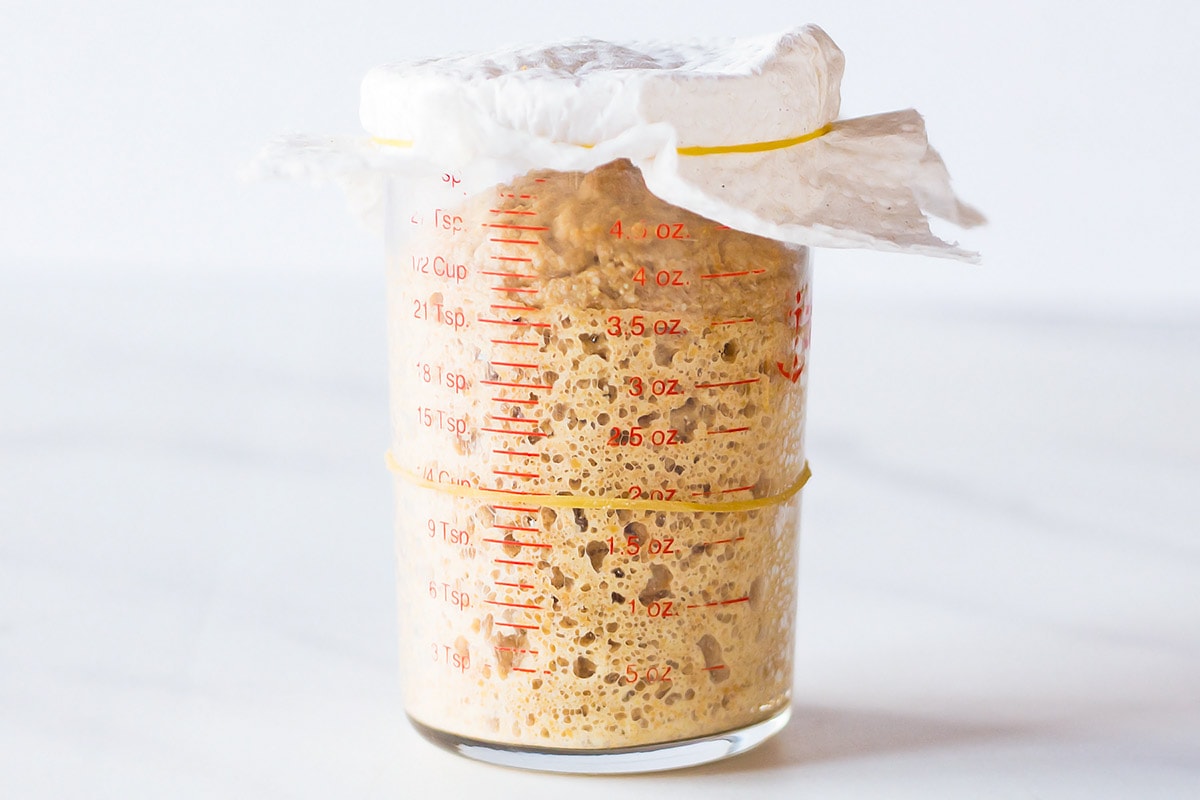
Why is Rye Good for Sourdough Starter?
There are many reasons why rye flour is a good choice for making a sourdough starter. For one thing, it attracts yeast more easily than traditional white flour, and as a result, it will ferment more quickly than sourdough starter with other types of flour. In fact, many bakers like to use a combination of rye flour and white flour in bread baking because they know that it will help them yield a more active starter.
However, a full rye starter is generally the best for achieving a loaf of bread that rises beautifully, with lovely pockets in the loaves, and a dark caramel colour on the outside.
Another benefit of using rye flour is that it has more nutrients than white flour. It is also a particularly flavourful flour, which can help yield tasty rye bread or even just a delicious undertone if you choose to use this starter in more traditional sourdough utilizing white flour.
More Sourdough Recipes You'll Love:
Recipe
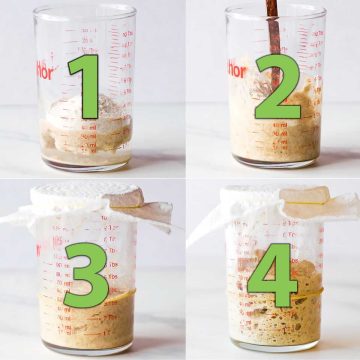
Rye Sourdough Starter
Equipment
- small jar
- lid
- rubber band
Ingredients
- 70 g rye flour* whole grain (also called dark rye flour); divided
- 70 g filtered water divided
Instructions
Day 1
- In the small jar stir together 10g rye flour (1 tablespoon) and 10g water (2 teaspoons). Scrape down the sides of the jar and place a rubber band at dough level. Loosely cover with a lid or paper towel attached with a rubber band.
Day 2
- You may already see some bubbles forming in your rye starter. Add 10g of rye flour and 10g of water and stir everything together. Scrape down the sides and move the rubber band up to the fill line. Cover loosely.
Day 3
- Now you may already see the starter has grown above the fill line marked with the rubber band (though it probably won't have doubled yet). Remove about half of the mixture and start a discard jar to keep in the fridge for future baking projects.
- To the remaining starter mix add 10g rye flour and 10g water. Stir together, and cover.
Days 4-7
- Repeat as day 3. Remove half of the starter mix into a discard jar. Feed the rest with 10g rye flour and 10g water. Keep an eye on the bubbles and growth. If the starter doubles in size in between feeds (but especially within the first 6 hours of feeding), it is fully active and ready to use.
Notes
Pin for later?
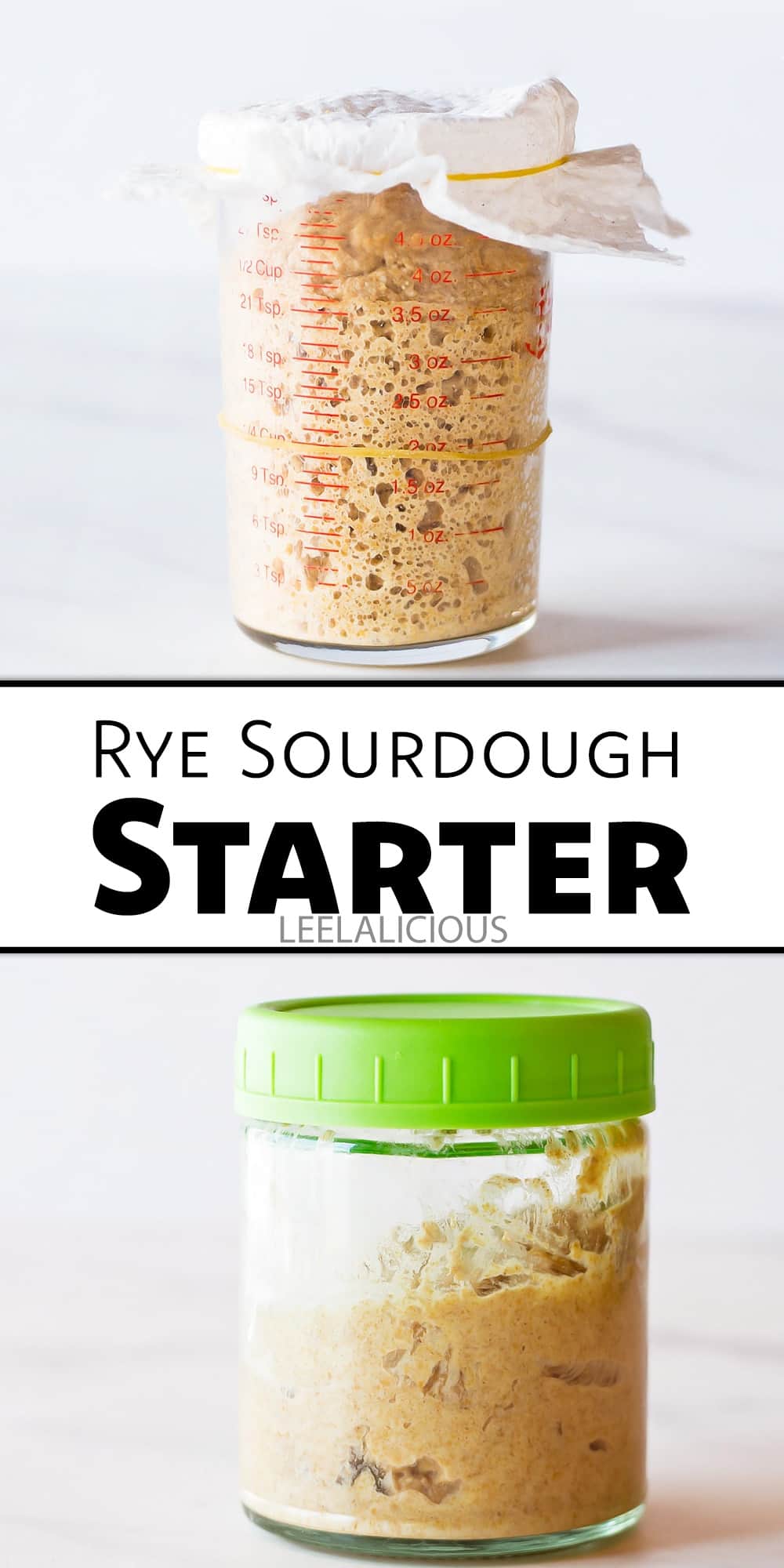
Common Questions
Yes, rye is an excellent choice, fostering quicker fermentation, richer nutrients, and enhanced flavor.
Lucky for you, only two ingredients are needed for this rye sourdough starter recipe: whole-grain rye flour and filtered water.
The starter is ready when it doubles in size within the first six hours after it is fed, or when a small portion dropped in water floats.
Once it becomes active, you can feed it 1-2 times a week or weekly if you don't bake frequently. You can also store it in the fridge when not baking and reactivate it later.
The sourdough discard can be saved in a discard jar and used in various recipes like sandwich bread, biscuits, pancakes, waffles, or any baking recipe that benefits from sourdough flavor.
Rye flour attracts yeast more easily and ferments faster than traditional white flour. It also yields a more active starter and provides more nutrients and flavorful results in bread baking.
Maintain a consistent feeding schedule, use warm water, and keep it in a slightly warmer environment to expedite rising.
A strong smell is common in rye starters. It's likely a result of the robust fermentation process, contributing to its distinct flavor.
Yes, rye flour often imparts a more pronounced sourdough flavor, adding depth and character to the final bread.


Joan
What pan should it be backed in?
Backed at what temperature?
Backed for how long?
How to test for doneness?
Cool for how long before removing from pan?
Should it be cooled on it's side like banana bread?
Jennifer @ Leelalicious
Hi Joan! Thanks for your questions. This rye sourdough starter simply acts as "the yeast" component in sourdough bread baking and shouldn't be baked on its own. Regina has several bread recipes that use a sourdough starter which you may want to look at including her No Knead Sourdough or her Rustic Sourdough Bread.
Feel free to let us know if you have any other questions.
Juste
Hello!
The amount of starter at the end of the process (day 7) will it be enough just for 1 loaf of bread?
Jennifer @ Leelalicious
Hi there, yes, it would be more than enough to make a loaf of bread. 🙂
Marty McIntyre
"To begin making your rye sourdough start, add 10 grams (1 tablespoon) of rye flour with 10 grams (2 teaspoons) of filtered water to a container or jar."
Is this a typo? 1 tablespoon= 2 teaspoons= 10 grams?
Jennifer @ Leelalicious
Hi Marty! Thanks for your question. It isn't a typo as the weight is in reference to the weight of each ingredient. Rye flour is lighter than water which is why 10 grams of flour yields 1 tablespoon while 10 grams of water is 2 teaspoons. Hope this helps but let us know if you have any other questions.
Kri
What flour do you feed it for the maintenance feeding?
Jennifer @ Leelalicious
Hi Kri! I recommend that you feed your starter with rye flour to keep it pure but you can definitely feed it with whole wheat or white flour instead if you prefer. The starter would just have less of a rye flavour moving forward as the other types of flour would dilute the rye over subsequent feedings.
Rob
To maintain the rye starter (past day 3), do you feed it only once per day? I feed my wheat starter (made with all purpose flour) twice per day when not refrigerating it. Is it the same with a rye starter?
Jennifer @ Leelalicious
Hi Rob! Thanks for checking in. Once the rye starter is active, Regina has found that she only needs to feed it once or twice a week. However, if you find that your starter doesn't maintain enough activity with that number of feedings, you can try to feed it a little more frequently if you like. Rye flour starter does tend to activate much more quickly than traditional sourdough starter made with white flour.
Phoenix VanEyll-Gallagher
Not sure why this didn't work for me, it just ended up being a very compacted paste at the bottom of my jar. It seemed like there wasn't enough liquid for the flour even after each feeding. In less than a week it became thick and hard and it was covered in mold.
Jennifer @ Leelalicious
Hi Phoenix! I'm sorry you had a challenging time making this starter. Making sourdough starter can be a challenging process, especially since it relies on naturally occurring yeasts to develop properly. I'm wondering if something could have been accidentally introduced into the mixture that might have set it off? Or else, did you use chlorinated water? Chlorine is generally harmful to yeast and may impact the starter's development as well.
Theresa
What do I do when I didn't read the entire recipe and made my starter with 70g of rye flor and 70g filtered water. :/
Regina | Leelalicious
No problem. You'll just have more discard more on day 3. Instead of half of the mix, discard everything but 20 g of sourdough mix. Then feed 10 g each rye flour and water. Process as directed.